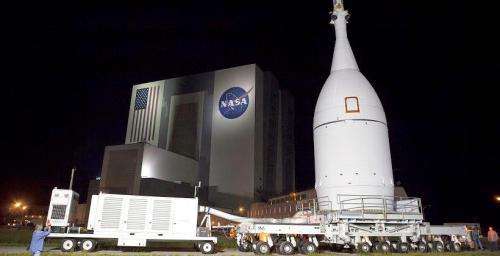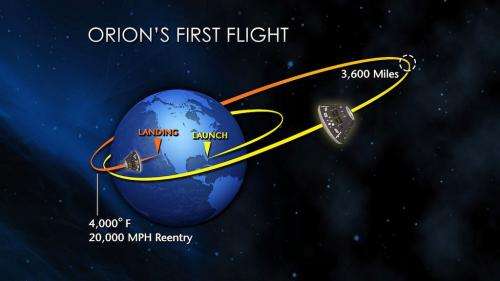Lockheed Martin keeps fingers crossed for Orion's first test flight

As we move closer to the highly anticipated first ever test flight of the Orion spacecraft, there's an aerospace company which would be keeping its fingers tightly crossed during this nail-biting moment for the U.S. spaceflight. Lockheed Martin which built the manned capsule that will take American astronauts far beyond Earth, is much more than excited about the milestone flight. "We live for this kind of project. We will tell our kids and our grandkids about this," Allison Rakes, Lockheed Martin spokesperson told Astrowatch.net. The company's hard working crew literally lives for this first step of future deep space exploration. "We've had a team in Florida working around the clock for the past several months preparing for this moment. Once that Delta IV lifts off, you're going to see quite the celebration," Rakes added.
Lockheed Martin is a global security and aerospace company. On Aug. 31, 2006, it was awarded a contract from NASA to design and build the Orion spacecraft. The company is responsible for the design, build, testing, launch processing and mission operations of the spacecraft. Having in mind the latest two spaceflight disasters - Orbital's Antares rocket explosion and Virgin Galactic's SpaceShipTwo crash - Lockheed Martin shows that safety is the main issue here. "The data we will collect during Exploration Flight Test -1 (EFT-1) will shape every future deep space mission, and will help to ensure that when a crew is onboard, our systems will keep them safe," Rakes said. "We're constructing Orion to be the safest spacecraft ever built. For example, to pull the crew to safety in an emergency on the launch pad or during descent, we've developed a Launch Abort System (LAS). The LAS has half a million pounds of thrust and accelerates from 0 to 500 mph in 2 seconds. It can pull the crew a mile up and a mile away from the launch pad in an emergency."
Orion will transport humans to interplanetary destinations beyond low Earth orbit, such as asteroids, the moon and eventually Mars, and return them safely back to Earth. During a space mission it is also important to keep astronauts safe mainly from deep-space radiation, severe cold and extreme heat. Lockheed Martin is convinced that their spacecraft has what it takes to ensure safety at the highest level.

On Dec. 4, Orion will travel 3,600 miles beyond Earth—15 times further than the International Space Station. It will return to Earth at a speed of approximately 20,000 mph for a splashdown in the Pacific Ocean. The test will provide engineers with data about systems critical to crew safety, such as heat shield performance, separation events, avionics and software performance, attitude control and guidance, parachute deployment, and recovery operations to validate designs of the spacecraft before it begins carrying humans. "EFT-1 will exercise all of Orion's re-entry systems, including testing the heat shield. We will evaluate the fluctuations between the temperatures and pressure across the shield during the re-entry, evaluate the performance of the thermal protection coating and we will also be looking at accelerations and strain during the water impact," Rakes revealed.
She also pointed out that Orion's heat shield (16.5 feet in diameter) is the largest ever built and is capable of protecting a crew from external temperatures of nearly 5,000°F. It also has a new resin system that can withstand higher temperatures and landing impact. "Orion will have to withstand landing loads of about 300,000 to 400,000 pounds - That's about equal to the mass of a full-size yellow school bus crashing into the ocean at 20 mph," Rakes noted. This resin was developed by the Lockheed Martin Orion thermal protection system team in partnership with TenCate Advanced Composites, a leading supplier of aerospace thermoset and thermoplastic prepregs.
During the test flight, the spacecraft will return to Earth at a speed of approximately 20,000 mph, but when returning from deep space, the velocity is much higher. "When a spacecraft re-enters Earth's atmosphere from deep space, it's plummeting at 25,000 mph, or Mach 33. During a re-entry from Mars, Orion would be travelling at about 27,000 mph," Rakes said.
Last week, Orion has completed a 22-mile, 6-hour journey from the Launch Abort System Facility at Kennedy Space Center, to launch pad 37 at Cape Canaveral Air Force Station in Florida. It was lifted about 200 feet up and mated to the United Launch Alliance (ULA) Delta IV Heavy rocket that is slated to take the spacecraft for its maiden flight high above.
What's next for Orion before December's lift off? "Leading up to EFT-1 in the next couple of weeks, the rocket and Orion will be integrated and powered up, and engineers will test and verify interfaces between the two in preparation for the test flight," Rakes revealed.
Let's keep our fingers tightly crossed, because the upcoming test will be crucial for U.S. space exploration. Human spaceflight far beyond Earth commences now, when the Delta rocket is about to make a one small step lifting the Lockheed Martin's craft, making another "giant leap for mankind" possible in the near future.
Source: Astrowatch.net





















